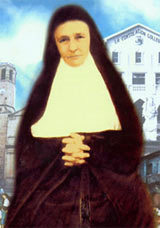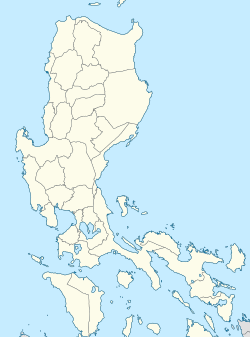
Pasig, officially the City of Pasig, is a highly urbanized city in the National Capital Region of the Philippines. According to the 2020 census, it has a population of 803,159 people.

Intramuros is the 0.67-square-kilometer (0.26 sq mi) historic walled area within the city of Manila, the capital of the Philippines. It is administered by the Intramuros Administration with the help of the city government of Manila.

Paco, formerly known as Dilao, is a district of Manila, Philippines located south of the Pasig River, and San Miguel, west of Santa Ana, southwest of Pandacan, north of Malate, northwest of San Andres Bukid, and east of Ermita. According to the 2020 census, it has a population of 79,839 people.

The Colegio de San Juan de Letran, also referred to by its acronym CSJL, is a private Catholic coeducational basic and higher education institution owned and run by the friars of the Order of Preachers in Intramuros, Manila, Philippines. It was founded in 1620. Colegio de San Juan de Letran has the distinction of being the oldest college in the Philippines and the oldest secondary institution in Asia. The school has produced Philippine presidents, revolutionary heroes, poets, legislators, members of the clergy, jurists, and it is also one of the only Philippine schools that has produced several Catholic saints who lived and studied on its campus. The school's patron saint is St. John the Baptist. The campus contains two statues, representing the two foremost alumni in the fields of secular and religious service: former Philippine President Manuel L. Quezon and Vietnamese Saint Vicente Liem de la Paz.

Gilbert Luis Ramos Centina III was a Filipino-American award-winning Roman Catholic poet who was the author of nine poetry books, two novels and a book of literary criticism. Respected for his poetry, his works have been anthologized in Philippine high school and college textbooks and published in the Philippines, Spain, Canada and the United States. Besides English, he also wrote in Spanish and in two Philippine languages, Hiligaynon and Tagalog. He received the Catholic Authors Award in 1996 from the Asian Catholic Publishers and the Archdiocese of Manila under Cardinal Jaime Sin. For his body of poetic work in Spanish which over the years "has become an anthroponymic treasure, memory of parishioners, companions and friends who give title to a fresco of earthly life, with its glories and miseries...," he was posthumously awarded the Premio José Rizal de las Letras Filipinas 2020.

La Consolación College Manila is a private Catholic basic and higher education institution run by the Augustinian Sisters of Our Lady of Consolation (ASOLC) in the City of Manila, Philippines. It was founded by the Augustinian Sisters in 1902 when the Apostolic Nuncio to the Philippines offered ten Filipino nuns from the Augustinian Sisters of Our Lady of Consolation a house near the Basilica of San Sebastián.

Joaquina Maria Mercedes Josefa Barcelo y Pages, also known as Consuelo Barcelo y Pages, was a Roman Catholic Spanish Augustinian tertiary who cofounded the Augustinian Sisters of Our Lady of Consolation along with her sister, Rita Barcelo y Pages, in the Philippines. Born on July 24, 1857, and died on August 4, 1940, at the age of 83 in Manila.

The National Historical Commission of the Philippines is a government agency of the Philippines. Its mission is "the promotion of Philippine history and cultural heritage through research, dissemination, conservation, sites management and heraldry works." As such, it "aims to inculcate awareness and appreciation of the noble deeds and ideals of our heroes and other illustrious Filipinos, to instill pride in the Filipino people and to rekindle the Filipino spirit through the lessons of history."

Historical markers are installed by the National Historical Commission of the Philippines (NHCP) and its predecessor agencies in the Philippines and places abroad that signify important and historic events, persons, structures, and institutions. The commemorative plaques are permanent signs installed by the NHCP in publicly visible locations on buildings, monuments, or in special locations. The NHCP also allows local municipalities and cities to install markers of figures and events of local significance, although these markers are barred from using the seal of the Republic of the Philippines.

The Diocesan Shrine and Parish of Our Lady of Light, commonly known as Cainta Church, is a Roman Catholic parish church located along Andres Bonifacio Avenue in Barangay San Andres, Cainta, Rizal, in the Philippines. The church also operates a neighboring school, Cainta Catholic College. From its time of erection as a parish in 1760 until 1983, it belonged to the Archdiocese of Manila. It was placed under the newly created Diocese of Antipolo in 1983, which is now headed by Ruperto C. Santos. It belongs to the Vicariate of Our Lady of Light.

The Anda Monument, often erroneously referred to as the Anda Circle after the roundabout it is currently located, is an obelisk monument situated in the boundary of Intramuros and Port Area in central Manila, Philippines. It was erected in honor of Simón de Anda y Salazar, the Governor General of the Philippines from 1770 to 1776. The Anda Circle, the roundabout, is an interchange system at the junction of Bonifacio Drive, Mel Lopez Boulevard, Andres Soriano Avenue, and Roberto Oca Street.

The Transfiguration of Our Lord Parish Church is the only Roman Catholic church in Cavinti, Laguna, Philippines. Its titular patron is Señor del Trasfiguracion or commonly known as El Salvador del Mundo whose feast day is celebrated every August 6. The Our Lady of Snows and St. Joseph, husband of Mary served as the town's secondary patrons.

Colegio de Santa Rosa - Manila is a private Catholic school run by the Congregation of the Augustinian Recollect Sisters in Intramuros, Manila, Philippines. It was established on August 30, 1750 as the Beaterio y Casa de Segunda Enseñanza by Mother Paula de la Santissima Trinidad to educate the young Spanish - Filipino women. It was originally an All Girls school until the early 2000 when it converted to a co-ed educational institution. It acquired its present name on 1774 but was also known by several other names including Colegio de Madre Paula and Beaterio y Casa de Enseñanza.

San Vicente de Paul Church, also known as the Archdiocesan Shrine of Our Lady of the Miraculous Medal, is a Roman Catholic church located in Ermita, Manila, Philippines.

The Bataan Provincial Building or Bataan Provincial Capitol is the seat of the provincial government of Bataan in the Philippines.





















